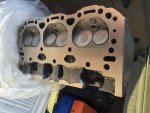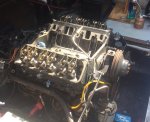1998 Mercrusier 5.7L with 2 bbl carb. FWC.
M048938
720 hrs
Looking for advice. I am considering pulling the heads to have them refurbished during the offseason. (Reason why added below.) Boat will be outside under shrink wrap while heads are off.
I read that it is NOT recommended to drain engine coolant for storage over winter, as this will promote rusting of internal surfaces. But, coolant will need to be drained in order to pull the heads.
Anything I could do to prevent rusting of internal surfaces? Add coolant back into block after heads are pulled? Other?
---------------------------------------------------------------------------------
Reason for the work:
Compression test at the end of this season came back with very low compression on #5. These are the results from Oct 2020, which was a "dry test" on a cold engine:
1 - 180
3 - 180
5 - 30
7 - 180
2 - 180
4 - 185
6 - 185
8 - 185
I sprayed about 2 tablespoons of WD40 into #5 and ran compression test again. No improvement. Still only 30 psi.
Prior compression test, June 2019 (also a "dry test" on a cold engine) but using a different gauge:
1- 175
3 - 175
5 - 175
7 - 175
2 - 180
4 - 175
6 - 165
8 - 165
The exhaust manifolds and risers were replaced in May 2019. However, i don't know the age of the previous ones. So, I won't be surprised IF I find some rusting in the valves and valve seats on cylinders below the risers (on 3,5 and 4,6) once the heads are pulled.
This weekend, I'll be doing the following leak down test to try to further pinpoint the problem before i pull the heads:
M048938
720 hrs
Looking for advice. I am considering pulling the heads to have them refurbished during the offseason. (Reason why added below.) Boat will be outside under shrink wrap while heads are off.
I read that it is NOT recommended to drain engine coolant for storage over winter, as this will promote rusting of internal surfaces. But, coolant will need to be drained in order to pull the heads.
Anything I could do to prevent rusting of internal surfaces? Add coolant back into block after heads are pulled? Other?
---------------------------------------------------------------------------------
Reason for the work:
Compression test at the end of this season came back with very low compression on #5. These are the results from Oct 2020, which was a "dry test" on a cold engine:
1 - 180
3 - 180
5 - 30
7 - 180
2 - 180
4 - 185
6 - 185
8 - 185
I sprayed about 2 tablespoons of WD40 into #5 and ran compression test again. No improvement. Still only 30 psi.
Prior compression test, June 2019 (also a "dry test" on a cold engine) but using a different gauge:
1- 175
3 - 175
5 - 175
7 - 175
2 - 180
4 - 175
6 - 165
8 - 165
The exhaust manifolds and risers were replaced in May 2019. However, i don't know the age of the previous ones. So, I won't be surprised IF I find some rusting in the valves and valve seats on cylinders below the risers (on 3,5 and 4,6) once the heads are pulled.
This weekend, I'll be doing the following leak down test to try to further pinpoint the problem before i pull the heads:
- Bring #5 to JUST BEFORE TDC
- Disconnect exhaust pipe extension
- Remove flame arrestor
- Put plastic bag over top of carburetor
- Put plastic bag over exhaust pipe
- Plastic bag on xxxxxx, to check for air blowing into the crank case
- Pump compressed air into #5 and watch plastic bags






















